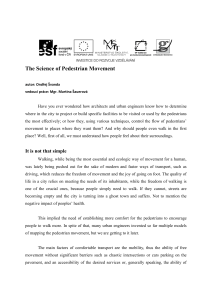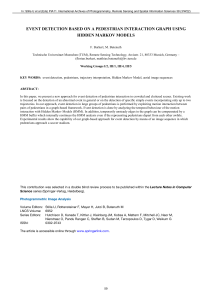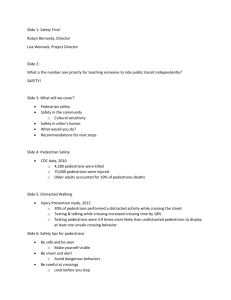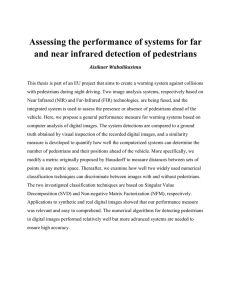Pedestrian Safety Second UN Global Road Safety Week A toolkit
advertisement
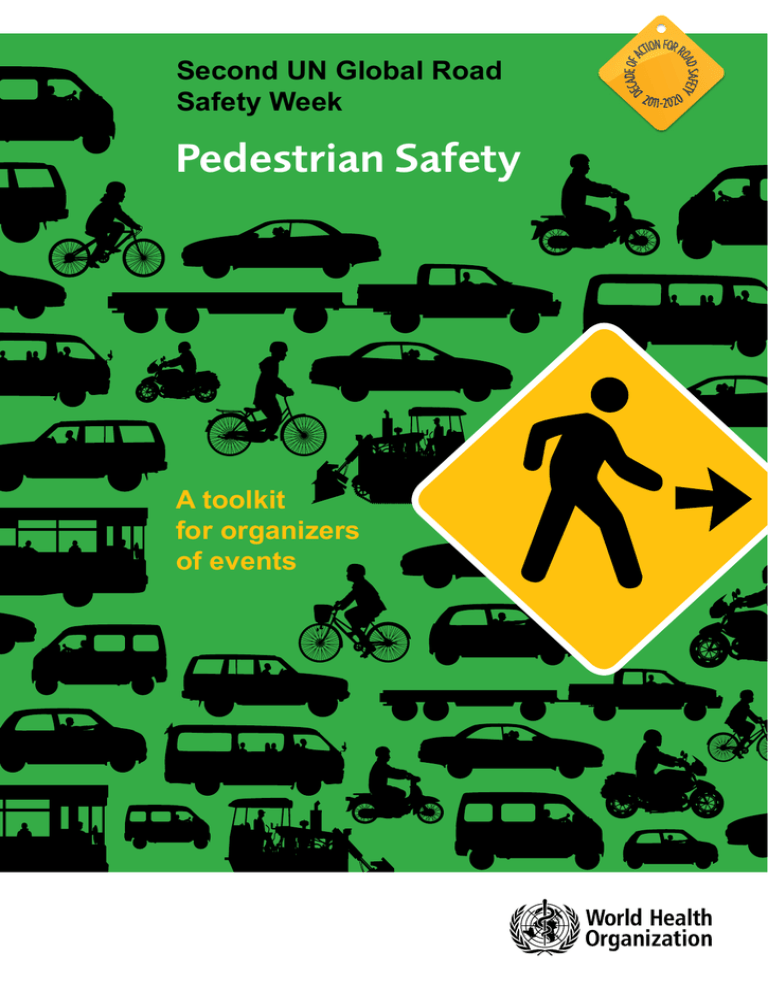
Second UN Global Road Safety Week Pedestrian Safety A toolkit for organizers of events This “toolkit for organizers” is intended as a guide to help plan activities and events during the Second UN Global Road Safety Week, which will be held 6-12 May 2013. The Week will be dedicated to pedestrian safety. The toolkit highlights the short- and long-term goals of the Week, explains its key messages, and gives ideas about the types of activities and events which may be planned and hosted. All stakeholders, including governments, nongovernmental organizations and their partners, are encouraged to join this global campaign to improve safety for pedestrians worldwide! About the Second UN Global Road Safety Week The Second UN Global Road Safety Week to be held 6-12 May 2013 is dedicated to pedestrian safety. Requested by the UN General Assembly, the Week will draw attention to the urgent need to better protect pedestrians worldwide, generate action on the measures needed to do so, and contribute to achieving the goal of the Decade of Action for Road Safety 2011-2020 to save 5 million lives. The Week will contribute to: ◆◆ drawing attention to the need for pedestrian safety; ◆◆ generating action on measures which work to increase pedestrian safety; and ◆◆ achieving the goal of the Decade of Action for Road Safety 2011-2020 to save 5 million lives. Governments, with support from civil society, academia, the private sector and the international community, are all encouraged to plan and host national and local events during the Second UN Global Road Safety Week. This milestone event on the Decade calendar is a unique opportunity to make progress on saving lives, and we hope that you will join in ensuring its success. Goals for the Week The Second UN Global Road Safety Week will draw attention to the need for pedestrian safety, generate action on measures which work to protect pedestrians, and contribute to achieving the goal of the Decade of Action for Road Safety 2011-2020 to save 5 million lives. Short-term goal: a fatality-free week More than 5000 pedestrians are killed on the world’s roads each week. The short-term goal for the Week is to prevent even a single pedestrian fatality during the period 6-12 May 2013. There are relatively simple actions that could be taken in advance of the Week to save pedestrian lives. With the support of technical experts, the following interventions could be initiated in communities around the world in the hope of making the Week fatality free: ◆◆ raising awareness of existing traffic laws on speeding, drinking and driving, distracted driving and walking, and pedestrian-rightof way; ◆◆ increasing enforcement of the above traffic laws; ◆◆ making “quick wins” to improve road infrastructure: –– improving lighting around facilities used by pedestrians; –– removing objects from streets which block facilities used by pedestrians; –– improving the safety of routes to and from schools and in school zones, including by establishing “walking school bus” programmes; –– enhancing the visibility of pedestrians by encouraging the use of reflective materials. Long-term goal: safe walking The ultimate goal of the Second UN Global Road Safety Week is to make a significant and long-lasting contribution towards making walking safe for the world’s pedestrians. This could be achieved through a number of measures which are known to save pedestrian lives. Although not an exhaustive list, some of the measures which could be put in place over the long-term include: ◆◆ installing and/or upgrading crosswalks, sidewalks, overpasses, underpasses, raised medians, and road signs and signals; ◆◆ lowering vehicle speed limits and otherwise “calming” streets with speed bumps, rumble strips and chicanes; ◆◆ developing and enforcing new and existing traffic laws on speeding, drinking and driving, distracted driving and walking, and pedestrian-right-of way; ◆◆ restricting or diverting vehicles from pedestrian zones; ◆◆ establishing and ensuring vehicle safety standards which protect pedestrians; ◆◆ improving mass transit route design; ◆◆ organizing and/or further enhancing trauma care systems and timely rehabilitation services; ◆◆ providing education and training to all road users and the public generally. Key messages for the Week The Second UN Global Road Safety Week, to be held 6-12 May 2013, offers a unique opportunity to draw attention to the issue of pedestrian safety. We are all pedestrians: on any given day, we choose to walk to and from our various destinations or – at a minimum – we begin and end most trips on foot. Walking requires no fare, no fuel, no license and no registration. It is integral to the liveability of our communities. Pedestrians comprise around one quarter of the annual global road deaths. Due to a lack of attention to their needs, and a tendency in recent decades to favour private motorized transport, pedestrians are today at an increased risk of death, injury and disability. Many of those killed are children and older people. The majority of fatalities occur in low-income and middle-income countries, settings where rapid motorization poses additional challenges; however, pedestrian safety remains a concern in countries worldwide. Much can be done to make our world more walkable, by providing safe, reliable and accessible facilities for all pedestrians. There is no single measure to adequately address the range of risks to pedestrians across various settings. Some of the most effective are managing vehicle speeds; separating pedestrians from other traffic by sidewalks and crosswalks; increasing the visibility of pedestrians; and ensuring the responsible behaviour of all road users. Enacting appropriate laws around such measures, enhancing enforcement and ensuring links with other modes of transport can save lives. Guaranteeing the safety of pedestrians will encourage walking which improves health. Walking reduces the risk of heart disease, stroke, diabetes, cancer, dementia, depression and obesity. As travel by motor vehicles is reduced, there are also declines in air and noise pollution, which also positively impact on health. Walking can make us healthier, fitter and leaner, and should become the safest and most convenient and pleasant option for most trips. Preparing for the Week We are all pedestrians, and as pedestrians, we are well placed to make a meaningful contribution to preparations for the Second UN Global Road Safety Week. Those who have a convening role to play in their country or community include senior government officials from ministries of health, transport and education as well as the nation’s focal point for the Decade of Action for Road Safety 2011-2020; representatives of nongovernmental organizations, including pedestrian associations; road safety professionals; health care providers; educators; students; insurers; road builders; vehicle manufacturers; the media; and victims of road traffic crashes and their families. Establish a planning committee representing all relevant sectors of your country or community. The committee should provide overall strategic guidance and direction for the Week, and determine objectives and the activities and materials needed to achieve these. The objectives could support action towards achieving both the short-term and longterm goals of the Week to ensure a fatality free Week and foster safe walking in the years ahead. Plan events to be hosted during the Week in your country or community. Events can contribute to general awarenessraising about pedestrian safety, the impact that the lack of safety has on pedestrian victims and their families, and the measures which are urgently needed. Such events can attract media attention to expand the reach to policy-makers and the public at large. Make your plans early and register your events through the Week’s global web site. http://www.who.int/roadsafety/week/2013/ event_registration/en/index.html Contribute to the “Long Short Walk” by taking a photo or video of your walk to school or work, your favorite walk or just a stroll to the corner shop. Promoted by the international road safety community as a key activity for the Week, the Long Short Walk, an initiative of the Zenani Mandela Campaign, seeks to prioritize safe walking for all. The initiative aims to achieve a new global Sustainable Development Goal on safe walking. http:// www.makeroadssafe.org/longshortwalk/ Pages/homepage.aspx Develop materials for the Week to support the events you are planning. These may include a pamphlet, fact sheet, poster, press release or other advocacy product based on the latest data and information about pedestrians and their safety. Stories of road traffic victims as told by their families also make for powerful narratives to engage the attention of the media and support the events being planned. Brand your events and materials with the symbol of the Decade of Action for Road Safety 2011-2020. The Week is a key milestone in the ten-year Decade, and all governments and nongovernmental organizations are encouraged to use the Decade symbol to unite the many events and materials that will be prepared for the Week. To access the Decade symbol in various languages and file formats, register your agreement to the terms of use here: http://www.roadsafetyfund.org/ TagSymbol/Pages/TermsofUse.aspx . Hosting activities and events during the Week Activities and events marking the Second UN Global Road Safety Week will take place at local, national and regional levels. These may include initiatives such as seminars, campaign launches, and press conferences. Many could benefit from the support of leaders from pedestrian associations with experience in engaging policymakers and the public broadly, and individuals considered champions for the cause. All efforts should contribute towards making pedestrians safe. The following are some ideas and suggestions for activities and events which may be hosted during the Week: By policy-makers: ◆◆ with the newly released WHO Global status report on road safety 2013 as a basis for discussion, high-level policy dialogues, conferences or seminars to define or redefine a country’s approach to pedestrian safety; ◆◆ launch of new strategies or plans of action; ◆◆ enactment or enforcement of new or existing legislation; ◆◆ issuance and/or revision of national planning guidance for local administrations; ◆◆ release of new research; ◆◆ signing of charters. By and for the public: ◆◆ campaigns to encourage action on the short-term and long-term goals of the Week (see above), such as campaigns to raise awareness of existing traffic laws; increase enforcement; improve road infrastructure; enhance mass transit route design; and strengthen trauma care systems, among others; ◆◆ dissemination of information materials related to such campaigns; ◆◆ school-based initiatives, including improvements of the environment around schools to enhance the safety of pedestrians; ◆◆ public workshops and other educationoriented activities; ◆◆ street marches, demonstrations, parades, walks or related events; ◆◆ charity sports events or concerts; ◆◆ ceremonies dedicated to pedestrian road traffic crash victims, such as remembrance gardens or Internet-based memorials. With and through the media: ◆◆ press conferences; ◆◆ radio or television talk-shows; ◆◆ letters to the editor in the print media; ◆◆ special newspaper supplements; ◆◆ televised debates; ◆◆ other efforts drawing the attention of the media to new road safety data, reports and initiatives. Conclusion The Second UN Global Road Safety Week offers a one-off chance to draw attention to the challenges faced by pedestrians in settings across the world. Never before has a global event of this importance been dedicated to pedestrian safety. Through the various activities and events which will be hosted, the Week will catalyze concrete action towards safe, reliable and accessible facilities for all pedestrians. The end result will be a world which is more walkable and healthy. In addition Join us on Facebook http://www.facebook.com/roadsafetydecade Follow us on Twitter http://www.twitter.com/UNRSC Share photos on Flickr http://www.flickr.com/groups/ roadsafetydecade Visit our web site and make use of our advocacy materials http://www.who.int/roadsafety/week/2013/ en/index.html Contact Ms Laura Sminkey Communications Officer Email: sminkeyl@who.int Tel: +41 22 791 4547 WHO acknowledges the generous financial support of the United States Centers for Disease Control and Prevention to the publication of this toolkit.
